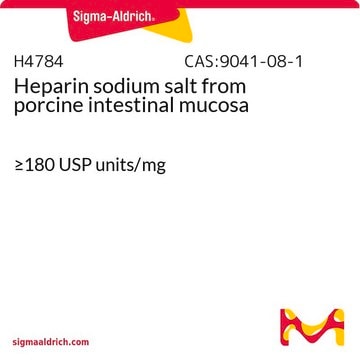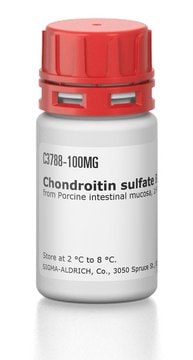The solubility of this item is 1mg/ml as mentioned on the COA.
Link to sample COA: https://www.sigmaaldrich.com/certificates/sapfs/PROD/sap/certificate_pdfs/COFA/Q14/H7640-5MG0000336127.pdf
Wichtige Dokumente
H7640
Heparan-Sulfat Natriumsalz aus Rinderniere
powder, extracellular matrix component
Synonym(e):
Heparitinsulfat
Größe auswählen
Größe auswählen
About This Item
Empfohlene Produkte
Produktbezeichnung
Heparan-Sulfat Natriumsalz aus Rinderniere,
Lagertemp.
2-8°C
Suchen Sie nach ähnlichen Produkten? Aufrufen Leitfaden zum Produktvergleich
Anwendung
- um seine Wirkung auf die Proliferation von B-Zellen zu untersuchen[1]
- um seine Rolle bei der Entwicklung von Augen in E5-Embryrozellen zu untersuchen[2]
- um seine Bindung an Exosom-Fibronektin in menschlichen Trabekelwerkzellen mittels Dot Blot zu untersuchen[3]
Biochem./physiol. Wirkung
Lagerklassenschlüssel
11 - Combustible Solids
WGK
WGK 3
Flammpunkt (°F)
Not applicable
Flammpunkt (°C)
Not applicable
Persönliche Schutzausrüstung
Eyeshields, Gloves, type N95 (US)
Hier finden Sie alle aktuellen Versionen:
Analysenzertifikate (COA)
Die passende Version wird nicht angezeigt?
Wenn Sie eine bestimmte Version benötigen, können Sie anhand der Lot- oder Chargennummer nach einem spezifischen Zertifikat suchen.
Besitzen Sie dieses Produkt bereits?
In der Dokumentenbibliothek finden Sie die Dokumentation zu den Produkten, die Sie kürzlich erworben haben.
Kunden haben sich ebenfalls angesehen
Artikel
Uncover more about glycosaminoglycans and proteoglycans including the structure of glycosaminoglycans (GAGs), the different types of GAGs, and their functions.
Glycosaminoglycans are large linear polysaccharides constructed of repeating disaccharide units.
-
What solvent should i use to dissolve this?
1 answer-
Helpful?
-
-
Wo finde ich eine Angabe zum Molekulargewicht?
1 answer-
The molecular weight of this product is not determined. However, data from collective articles suggests the molecular weight could be around 14000 Da.
Helpful?
-
Active Filters
Unser Team von Wissenschaftlern verfügt über Erfahrung in allen Forschungsbereichen einschließlich Life Science, Materialwissenschaften, chemischer Synthese, Chromatographie, Analytik und vielen mehr..
Setzen Sie sich mit dem technischen Dienst in Verbindung.









